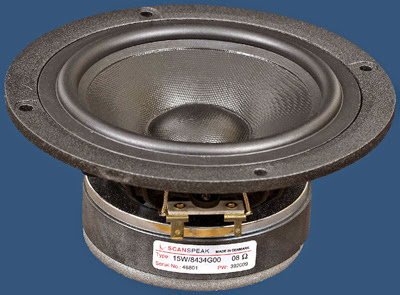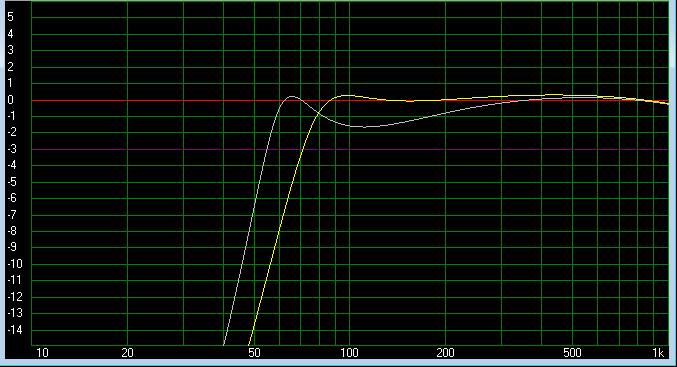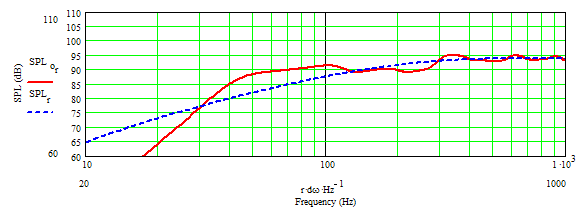I have been messing around with transmission line theory for a number of years now - built numerous of them, and pretty much fell in love with the sound you can get out of them when properly executed.
So much so, that many people who have asked me what I think the ultimate speaker implementation is would have heard my unwavering answer: TQWT (tapered quarterwave tube). I love these because of the openness and detail they can produce. If you do it right, the box sound is also pretty much a thing of the past. I don't think there is anything better.
Now many of you will think that transmission lines are remnants from the past. You remember old magazines with yellow pages which were scanned and shown on the internet from the 1950s and 60s. What many will not know is that no effective way existed for modelling and simulating these types of cabinets until late in the last century / early this century when a clever man called Martin J King released a number of tools for this purpose.
What the guys used to do in the old days is to build numerous different types of enclosure, and based on hundreds if not thousands of hours worth of experimentation, would fine tune a particular enclosure to work with a specific driver. This is how nearly all those old school tranmission lines were designed, including many of the Fostex and similar designs still published today.
Anyway, since I am stuck here in China for the time being I finally decided to try and use some of Mr. King's tools. In the past I had used a number of other much more simplistic tools for my designs, and tweaked until they sounded right.
Mr. King's tools bring an entirely new level of accuracy. It allows for minute changes to things like driver location, multiple segments of varying cross sectional area, stuffing densities, etc, etc. Obviously this also means that using the tools requires a heavy learning curve. These tools make something like WinISD look like a child's toy... :faint: Honestly, after spending some time with the MathCad tools I don't think I will use anything else again - there is just no point :nfi:
So I have been playing around and learning how to use these things over this past weekend, and have finally reached a level where I can now start to understand what I am doing. By no means am I an expert - I would say that I am barely scratching the surface of what can be done.
What I want to show you here is why we would decide to build a quarterwave family enclosure by doing a comparison to a bass reflex enclosure using the same driver.
All simulations were done using two 5.25" Scan Speak Discovery drivers (15W/8434 g00) connected in parallel for a 4 ohm load. You can get these drivers from Madisound for around US$64 each. I already have some in my speaker stockpile cupboard, which is why I am doing the simulations on them:

These drivers are mainly suitable for small bookshelf type speakers - they work in a small cabinet, and don't proclaim to be a subwoofer, meaning they don't make huge amounts of deep bass. They do however have a very nice and light cone weighing in at around 8.6 grams (including VC assembly and air mass) as well as a reasonable motor with a force factor (BL) of 7.3 T.M Resonance frequency is quoted as 45 Hz. When used for midrange duty, these drivers are surprisingly good considering the low price.
So this is pretty much the best bass (usable) performance I can get out of these when doing a simulation in WinISD:

As you can see, the bass doesn't reach very low at all:
* The yellow line shows a 10 liter enclosure tuned to 73Hz. This gives a nearly flat response with F3 being around 71Hz.
* The white line shows a 20 liter enclosure tuned to 59Hz. This gives an F3 of 55Hz, but the price paid is a nearly 2dB dip around 110Hz.
Looking at that, you would definitely not use this driver for bass duty in any reasonable loudspeaker. 60Hz F3 could be listenable, but you would be missing out on bass in a big way. This is where the quarter wave family of enclosures come into their own.
Take a look at this response graph generated by Mr. King's simulation tools and about an hour worth of my time:

Things look significantly different here - we can achieve a very usable bass response down to around 40Hz using the same 2 drivers!
Sure, the graph does not look all that nice and smooth, but:
1. After playing around with these tools, I believe that any enclosure will create these types of bumps and dips - it's just that tools such as WinISD are not advanced enough in the calculations to actually show them to you.
2. I could potentially get this looking a bit better, but will need to spend more time learning how to use Mr. King's software, so give me some leeway on that front if you don't mind :-[
You will also notice that the overall bass response droops slowly starting around 250Hz. I am not sure why exactly that is, but I expect it may be the price we pay for the added bass extension somehow (more learning on my side will clear this up). I am however rather pleased with this because it should in theory work out very well when you consider the effects of room gain.
Obviously the cabinet size here is far larger than what you would have when using a bass reflex design, but it is by no means huge. Bigger is better seems to apply in this domain...
Finally, the simulation tools from Martin J King can purchased for the surprisingly low amount of US$ 25 from him by sending the funds via paypal. He will then send you a username and password to access the files. More info can be found on his website: http://www.quarter-wave.com/
If you feel the motivation to gain a deeper knowledge and understanding of speaker design (including bass reflex, TL, TQWT, ML-TL, horn, OB, etc) then please purchase this software - if you consider how much time must have gone into creating this as well as the power it gives you in design and fine tuning then there is simply no reason not to get it: It is a huge bargain!
Cheers,
Ian.
So much so, that many people who have asked me what I think the ultimate speaker implementation is would have heard my unwavering answer: TQWT (tapered quarterwave tube). I love these because of the openness and detail they can produce. If you do it right, the box sound is also pretty much a thing of the past. I don't think there is anything better.
Now many of you will think that transmission lines are remnants from the past. You remember old magazines with yellow pages which were scanned and shown on the internet from the 1950s and 60s. What many will not know is that no effective way existed for modelling and simulating these types of cabinets until late in the last century / early this century when a clever man called Martin J King released a number of tools for this purpose.
What the guys used to do in the old days is to build numerous different types of enclosure, and based on hundreds if not thousands of hours worth of experimentation, would fine tune a particular enclosure to work with a specific driver. This is how nearly all those old school tranmission lines were designed, including many of the Fostex and similar designs still published today.
Anyway, since I am stuck here in China for the time being I finally decided to try and use some of Mr. King's tools. In the past I had used a number of other much more simplistic tools for my designs, and tweaked until they sounded right.
Mr. King's tools bring an entirely new level of accuracy. It allows for minute changes to things like driver location, multiple segments of varying cross sectional area, stuffing densities, etc, etc. Obviously this also means that using the tools requires a heavy learning curve. These tools make something like WinISD look like a child's toy... :faint: Honestly, after spending some time with the MathCad tools I don't think I will use anything else again - there is just no point :nfi:
So I have been playing around and learning how to use these things over this past weekend, and have finally reached a level where I can now start to understand what I am doing. By no means am I an expert - I would say that I am barely scratching the surface of what can be done.
What I want to show you here is why we would decide to build a quarterwave family enclosure by doing a comparison to a bass reflex enclosure using the same driver.
All simulations were done using two 5.25" Scan Speak Discovery drivers (15W/8434 g00) connected in parallel for a 4 ohm load. You can get these drivers from Madisound for around US$64 each. I already have some in my speaker stockpile cupboard, which is why I am doing the simulations on them:

These drivers are mainly suitable for small bookshelf type speakers - they work in a small cabinet, and don't proclaim to be a subwoofer, meaning they don't make huge amounts of deep bass. They do however have a very nice and light cone weighing in at around 8.6 grams (including VC assembly and air mass) as well as a reasonable motor with a force factor (BL) of 7.3 T.M Resonance frequency is quoted as 45 Hz. When used for midrange duty, these drivers are surprisingly good considering the low price.
So this is pretty much the best bass (usable) performance I can get out of these when doing a simulation in WinISD:

As you can see, the bass doesn't reach very low at all:
* The yellow line shows a 10 liter enclosure tuned to 73Hz. This gives a nearly flat response with F3 being around 71Hz.
* The white line shows a 20 liter enclosure tuned to 59Hz. This gives an F3 of 55Hz, but the price paid is a nearly 2dB dip around 110Hz.
Looking at that, you would definitely not use this driver for bass duty in any reasonable loudspeaker. 60Hz F3 could be listenable, but you would be missing out on bass in a big way. This is where the quarter wave family of enclosures come into their own.
Take a look at this response graph generated by Mr. King's simulation tools and about an hour worth of my time:

Things look significantly different here - we can achieve a very usable bass response down to around 40Hz using the same 2 drivers!
Sure, the graph does not look all that nice and smooth, but:
1. After playing around with these tools, I believe that any enclosure will create these types of bumps and dips - it's just that tools such as WinISD are not advanced enough in the calculations to actually show them to you.
2. I could potentially get this looking a bit better, but will need to spend more time learning how to use Mr. King's software, so give me some leeway on that front if you don't mind :-[
You will also notice that the overall bass response droops slowly starting around 250Hz. I am not sure why exactly that is, but I expect it may be the price we pay for the added bass extension somehow (more learning on my side will clear this up). I am however rather pleased with this because it should in theory work out very well when you consider the effects of room gain.
Obviously the cabinet size here is far larger than what you would have when using a bass reflex design, but it is by no means huge. Bigger is better seems to apply in this domain...
Finally, the simulation tools from Martin J King can purchased for the surprisingly low amount of US$ 25 from him by sending the funds via paypal. He will then send you a username and password to access the files. More info can be found on his website: http://www.quarter-wave.com/
If you feel the motivation to gain a deeper knowledge and understanding of speaker design (including bass reflex, TL, TQWT, ML-TL, horn, OB, etc) then please purchase this software - if you consider how much time must have gone into creating this as well as the power it gives you in design and fine tuning then there is simply no reason not to get it: It is a huge bargain!
Cheers,
Ian.

















